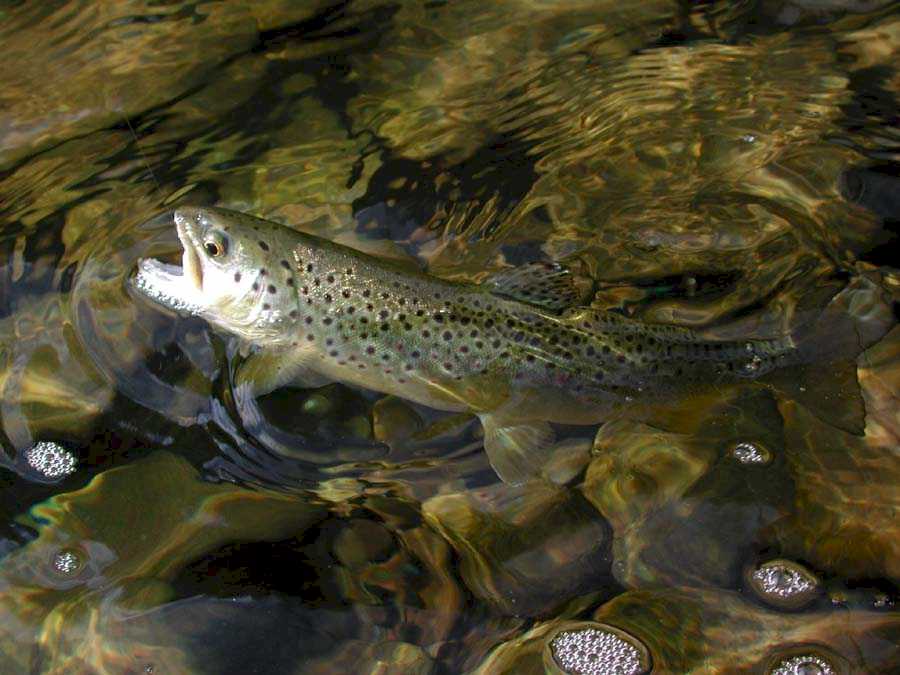Halloween - History - Customs - Games - Recipes - Rings - E-Cards
 SALMO TRUTTA
SALMO TRUTTATHE
BROWN
TROUT
Salmo Trutta, adaptable, intelligent and now distributed throughout the world, a favorite of the serious fisherman an exasperation to others and a species that’s captured the imagination of those who angle for over two thousand years from ancient times and up until the present, philosophers, writers and the regular guy have become enamored of this fish and also with the tackle and tactics used to take them starting with the founders of western civilization, the ancient Greeks.The first mention of a fish resembling them is found in the literature of Plato and Aristotle, another Greek writer, Plutarch gave tips about the kind of lines one could use to catch them. The Romans where acquainted with Salmo Trutta too and In the 2nd century A.D. Roman rhetorician Claudius Aelian mentions the trout of Macedonia and how the locals used colorful feathers tied around a hook to capture this wary and elusive fish. Excavations in Norway and Sweden show the Vikings where well aware of the brown trout and it’s habits also as ancient campsites unearthed along the tributaries of lakes there contain trout bones and primitive hooks. In Irish mythology the brown was elevated to a diety, Ban Naomha a magical trout that swam in the sacred well of the sun, Kil-na-Greina in County Cork. Invisible to all but the second sighted it’s said that if one took three drinks from the well, crawled around it three times and then placed an egg sized stone upon the altar the trout would show itself and answer any question.
Far from regarding it as a diety but still holding it in reverence the English refined the pursuit and capture of brown trout into an artform, and tales of chasing them into great literature. In 1496 Dame Juliana Berners who wrote the first book devoted exclusively to fishing, (“A treatyse of Fysshynge with an Angle”) mentions brown trout and what flies one could use to fool them. One hundred fifty years later Izaac Walton, an avid fan of the same trout Dame Juliana described wrote perhaps the single most influential book ever published about sportfishing: “The Complete Angler, or the contemplative mans recreation”. Walton believed that the true angler fishes for the love of fishing and that catching fish by sporting means is far superior to any other method. What fish fits into this philosophy better than the brown?
As the British Empire spread throughout the world the English brought along their beloved trout and eventually every cold body of water the Union Jack flew over (that could support them) soon contained reproducing expatriate populations. To this day the progeny of these transplants still survive and thrive in such places as South Africa, India, Australia and New Zealand. I’ve even heard (via the internet) that there’s a river teeming with browns in the Falkland Islands!
What about it’s natural distribution, was this fine fish originally only limited to Europe?
No, the browns natural range is the widest of any salmonid form and they are found from the atlas mountains of Africa north to the glacial streams of Iceland, from The British Isles to western Siberia, even down into the middle east! (There are Brown trout in the steams flowing off Mt. Ararat, they are found in the upper Jordan River and even in the headwaters of the Tigrus/Eurphrates system. Salmo trutta is widespread across northern Iran throughout Afghanistan and abounded (as an anadromous strain) in the Black, Caspain and Aral seas).
How did they get to America and New Jersey? Well, it wasn’t the British that brought them here! The first Brown trout ova (eyed eggs) arrived in the states around 1880 at the cold spring fish hatchery on Long Island. Two distinct strains, one a lake dwelling variant from Loch Leven in Scotland the other a sleek red spotted stream fish native to the Black Forest of Germany (courtesy of fish culturist R. Von Behr). American trout enthusiasts seeking a substitute for the vanishing brook trout Imported them in hopes of providing some type of salmonidae sport fishing in rivers no longer able to support (because of pollution) the easily caught and colorful native trout.
At first American anglers where disappointed, “Too hard to catch” was the main complaint, “Dull, both in color and temperment” said others. This changed though once the appropriate tactics where applied and soon anglers more interested in a challenge than filling out a stringer sought them out.
The first brown trout to arrive in New Jersey probably swam in from the Delaware River as several major tributaries in the Pocono’s and Catskills received repeated stockings. Accounts from individuals around the turn of the century mention seeing strange dark colored trout ascending the rivers of western New Jersey and how they refused the flies one normally used for such fish. Over the next few years fishing clubs, the state and private landowners stocked them in almost every drainage available and many reproducing populations became established, some that survive to this day.
Though there still may be isolated pockets of pure Loch Leven or Von Behr browns for the most part the fish have interbred at hatcheries and in the wild to produce a distinctly American strain . Whatever their lineage, They are, still , as Linneus first described them, Salmo Trutta.
-NJTROUT File archived on 5:30:45 Aug 31, 2005 and retrieved from the Internet Archive on 6:34:13 Nov 4, 2012. This document saved from http://www.njtrout.com/summernjtrout/salmo_trutta.htm